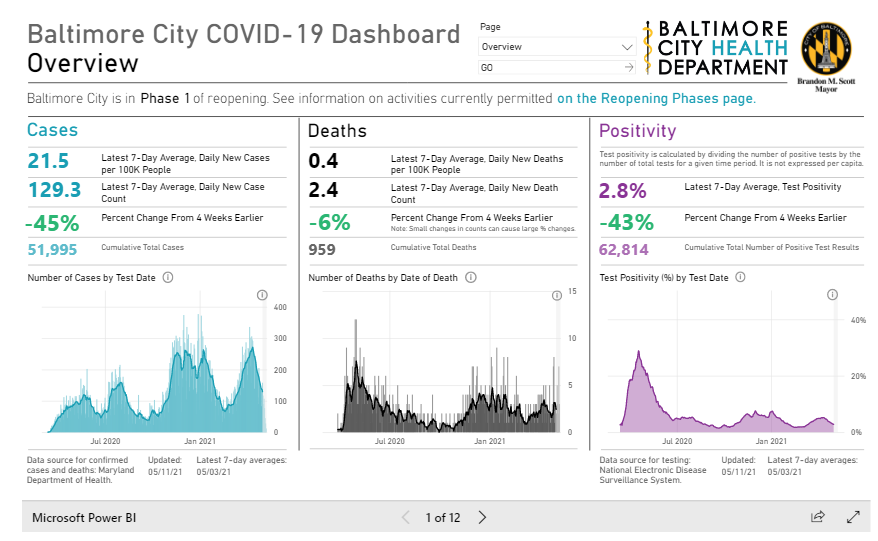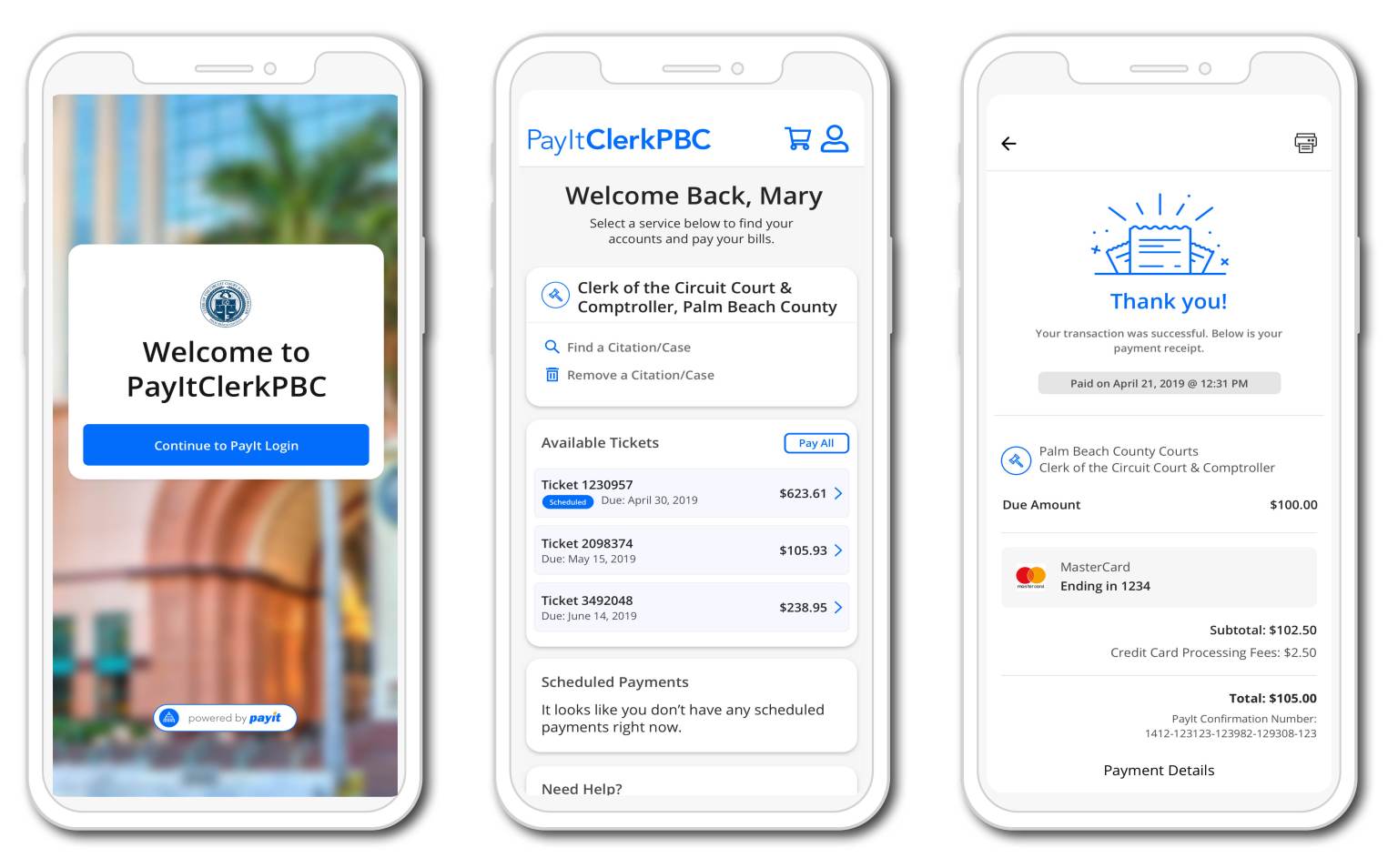As the novel coronavirus outbreak forced businesses, schools, and government offices to close or limit hours early in 2020, local governments suddenly found themselves at the forefront of providing information about the coronavirus, affected services, and available resources for citizens who needed health care, food or other services during the disruption.
Many cities quickly rolled out digital COVID-19 portals with information on closures, infection rates, emergency orders, testing sites, food pantry locations and eventually vaccination sites. These sites were and are valuable sources of trusted information for citizens navigating the new normal.

Image: City of Baltimore
However, local and state governments had to make other digital changes as well. Long lines at county tax offices and the DMV became a safety hazard, and social distancing requirements meant that many government employees needed to work from home—but the business of government had to continue. Making the pivot to digital under pressure wasn’t ideal, but many public sector organizations rose to the challenge. Here’s what we can learn from them, to be better prepared for the next eventual crisis.
Shift service delivery from in-person to digital, where possible
Before the pandemic, the Unified Government of Wyandotte County and Kansas City, Kansas, had already established a digital portal powered by PayIt where residents could pay their property taxes, pay court citation fines and file reports with 311.
By April 2020, as health concerns closed city and county offices, the organization realized it needed to expand its capabilities. They used PayIt Express, a quick-launch Software as a Service (SaaS) solution, to help residents digitally:
- Make Meals on Wheels donations.
- Pay for licenses and fees.
- Pay vehicle title and first-time vehicle fees.
- Buy 60-day vehicle permits.
- Purchase parking passes.
Remote payments not only offer safety and access when offices are closed, they meet citizen’s overall preferences for convenience: a 2020 consumer survey found that 67% would rather pay one-time bills digitally.
Other services can benefit from digital transformation, as well. For example, the State of Colorado rolled out a cloud-based unemployment portal to replace a mainframe system that couldn’t keep up with the volume of pandemic-related job loss claims. The new system is easier to use because it merges data from multiple systems for faster processing. It also has better security and fraud controls, to prevent scammers from stealing funds meant for out-of-work Coloradans.
Maintain services and revenue streams
Even during shutdowns, governments still need to provide public services and they still need to collect revenue. Rapidly pivoting to digital options helped many local governments keep going safely during the early stages of the pandemic response plan.
For example, the City of St. Louis added a PayIt Express page to their digital portal in order to shift in-person tax payments online quickly. By doing so, they were able to collect over $2 million in online earnings tax payments, which made up one-third of the city’s budget and went directly to city services.
Palm Beach County in Florida also rapidly expanded their digital services to citizens and businesses. The county reported that the move saved 37% of the revenue that they would have lost due to office closures from March to May 2020.

Image: Palm Beach County
In all, the government organizations using PayIt Express since the start of the pandemic collected $5.4 million in revenue through their PayIt Express pages from Q2 through Q4 2020. And PayIt Express continues to give them a cost-effective way to keep taking payments and providing services to people who need or simply prefer a digital option for their government interactions.
Automate manual processes and simplify operations
“From telehealth to telework, virtual courts to virtual education, agile regulation to rapid digitization—rarely in modern history have we seen so many large-scale experiments in government rolled out so quickly and at such a massive scale.”
Deloitte, Creating the government of the future. November 2020.
Digital services benefit governments, too. The Center for Digital Government found that more than half of government leaders at different levels view digital government transformation as key to streamlining workflows and giving employees more flexibility to work remotely. Thirty-two percent said they expect these changes to improve employee satisfaction with their jobs.
For example, automated reconciliation of payments for utility bills, license renewals and property taxes happens in seconds or minutes each day, compared to hours each week. That shift allows for faster updates, fewer data-handling errors and less time spent on tedious, repetitive work. That automation also reduces the need for employees to process payments in person or via paper checks, which frees them to work remotely and reduces their risk of getting sick at work.
Protect digital channels from cyber attacks
Government agencies were a popular target for ransomware attacks and data theft even before the COVID-19 pandemic. During the shutdown, however, those attacks accelerated at a time when more agencies and citizens depended on digital channels.
For example, the 2020 nation-state attack on SolarWinds, a software vendor for many government agencies, led to intrusions at multiple local and state government agencies in addition to breaches at several federal agency departments. Other headline-making incidents, like the 2020 Click2Gov formjacking attack that stole payment data from online bill-payers in 8 cities, drove home the need for stronger security measures at all levels of government.
In all, government organizations in the U.S. lost more than $18 billion in lost productivity and recovery expenses to ransomware attacks, according to Comparitech research. There’s no reason to expect the rate of attacks to decrease soon. That means agencies need to follow security best practices when they roll out digital services, including:
- Ensuring that platform integrations with systems of record are configured correctly.
- Using a platform built on AWS GovCloud to meet FEDRAMP and other high-level government data security and access standards.
- Tokenizing, encrypting and monitoring data.
- Complying with PCI-DSS standards for payment processing.
- Adopting anti-phishing tools and best practices.
- Continuously updating software and operating systems and improving security.
Leverage insights and reports from the cloud
When agencies have all the data related to their digital services unified in the cloud, it’s easier to analyze than when that data is strewn across departmental silos and formats. It also makes it easier to process data rapidly and share the results fast, which is critical for sharing constantly changing public information like local virus positivity rates, vaccination rates, case counts and threat levels.
Internally, cloud-based analytics and reporting help at the employee and at the organizational level. At the agency level, data analysis can help identify trends that help with budgeting and service planning, to eliminate inefficiencies and improve services. For example, when mass vaccination site visits decline, health districts can see that trend emerge in near real-time and adjust their campaigns to suit changing citizen behavior.
For employees, the ability to see data in real-time can save them time and frustration when they’re helping citizens with questions about their account balances, permit renewal requirements, court obligations and other issues. Data that reflects the latest payments and next steps can also save them time on issuing bills for balances, tickets, or court fines that have already been paid.
In one case, automated digital public service processes led to a 60% reduction in case-handling effort, according to McKinsey and a 50% reduction in time that citizens spent engaging with public administration. That kind of boost in efficiency can free employees to spend more time resolving complicated citizen problems, training on new tools or working on other projects.
Work smarter, prepare for the next disruption
As different government departments and agencies make the digital transformation, they can work together more efficiently as well. At the local level, Deloitte calls this convergence of data and technologies to optimize service delivery the “smart city.”
However, digital collaboration can exist among all levels of the public sector to improve citizen service during the pandemic and beyond, while reducing the touchpoints required for residents to access benefits and services. For example:
- Colorado’s new unemployment platform allows state residents to apply for federal government pandemic relief in addition to state benefits.
- The State of Kansas has partnered with Shawnee and Smith counties for property tax collection and secure tax digital record storage through its iKan platform.
As more governments and agencies move their operations to the cloud for safety and efficiency, they’re also positioning themselves for a faster response the next time a crisis arises.
“44% of agencies at all levels of government said more digital services will help them prepare for the next disruptive event.”
Center for Digital Government, Driving Digital Transformation in the Public Sector, 2020.
The more prepared government is at every level for pandemics, natural disasters and other disruptions, the faster and more effectively it can help citizens–without overwhelming IT infrastructure, employees and operating budgets.
Make your government agency more efficient, more prepared and more convenient. Learn more about building your digital government platform.
